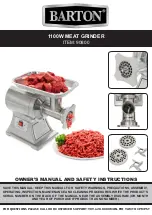
Operation
Note:
Determine the left and right sides of the
machine from the normal operating position.
Before Operation
Before Operation Safety
General Safety
•
Have the property or work area marked for buried
lines and other objects, and do not dig in marked
areas; note the location of unmarked objects and
structures, such as underground storage tanks,
wells, and septic systems.
•
Inspect the area where you will use the equipment.
– Evaluate the terrain to determine what
accessories and attachments you need to
properly and safely perform the job.
– Remove all debris.
– Ensure that the area is clear of bystanders
before operating the machine.
– Stop the machine if anyone enters the area.
•
Become familiar with the safe operation of the
equipment, operator controls, and safety decals.
– The owner is responsible for training all
operators and mechanics.
– Never allow children or untrained people
to operate or service the machine. Local
regulations may restrict the age or require
certified training of the operator.
– Know how to stop the machine and shut off the
engine quickly.
– Check that the operator's presence controls,
safety switches, and shields are attached
and functioning properly. Do not operate the
machine unless they are functioning properly.
– Locate the pinch-point areas marked on the
machine and attachments; keep your hands
and feet away from these areas.
– Stop the machine, shut off the engine, and
remove the key before leaving the operating
position.
Fuel Safety
•
Use extreme care in handling fuel. It is flammable
and its vapors are explosive.
•
Extinguish all cigarettes, cigars, pipes, and other
sources of ignition.
•
Use only an approved fuel container.
•
Do not remove the fuel cap or fill the fuel tank
while the engine is running or hot.
•
Do not add or drain fuel in an enclosed space.
•
Do not store the machine or fuel container where
there is an open flame, spark, or pilot light, such
as on a water heater or other appliance.
•
If you spill fuel, do not attempt to start the engine;
avoid creating any source of ignition until the fuel
vapors have dissipated.
•
Do not fill containers inside a vehicle or on a truck
or trailer bed with a plastic liner. Always place
containers on the ground, away from your vehicle
before filling.
•
Remove the equipment from the truck or trailer
and refuel it while it is on the ground. If this is not
possible, then refuel from a portable container
rather than a fuel-dispenser nozzle.
•
Keep the fuel-dispenser nozzle in contact with
the rim of the fuel tank or container opening at
all times until fueling is complete. Do not use a
nozzle lock-open device.
Adding Fuel
Recommended Fuel
•
For best results, use only clean, fresh (less than
30 days old), unleaded gasoline with an octane
rating of 87 or higher ((R+M)/2 rating method).
•
Ethanol
: Gasoline with up to 10% ethanol
(gasohol) or 15% MTBE (methyl tertiary butyl
ether) by volume is acceptable. Ethanol and
MTBE are not the same. Gasoline with 15%
ethanol (E15) by volume is not approved for use.
Never use gasoline that contains more than
10% ethanol by volume
, such as E15 (contains
15% ethanol), E20 (contains 20% ethanol), or E85
(contains up to 85% ethanol). Using unapproved
gasoline may cause performance problems and/or
engine damage which may not be covered under
warranty.
•
Do not
use gasoline containing methanol.
•
Do not
store fuel either in the fuel tank or fuel
containers over the winter unless you use a fuel
stabilizer.
•
Do not
add oil to gasoline.
Using Stabilizer/Conditioner
Use fuel stabilizer/conditioner in the machine to keep
the fuel fresh longer when used as directed by the
fuel-stabilizer manufacturer.
Important:
Do not use fuel additives containing
methanol or ethanol.
13














































